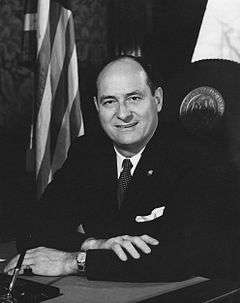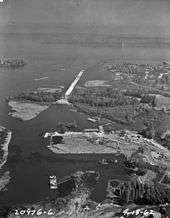Albert Rosellini
| Albert Rosellini | |
|---|---|
 | |
| 15th Governor of Washington | |
|
In office January 14, 1957 – January 11, 1965 | |
| Lieutenant | John Cherberg |
| Preceded by | Arthur B. Langlie |
| Succeeded by | Daniel J. Evans |
| Member of the Washington Senate | |
|
In office 1939–1949 | |
| Personal details | |
| Born |
Albert Dean Rosellini January 21, 1910 Tacoma, Washington |
| Died |
October 10, 2011 (aged 101) Seattle, Washington |
| Resting place |
Calvary Cemetery Seattle, Washington |
| Political party | Democratic |
| Spouse(s) | Ethel K. McNeil |
| Profession | Lawyer |
| Religion | Catholic |
Albert Dean Rosellini (January 21, 1910 – October 10, 2011) was an American politician, the 15th governor of the state of Washington for two terms, from 1957 to 1965, and was the first Italian American and Roman Catholic governor elected west of the Mississippi River.[1]
During a political career that spanned 40 years, Rosellini was an activist leader who worked to reform the state's prisons and mental health facilities, expand the state highway system, create the University of Washington's medical and dental schools, and build the second floating bridge across Lake Washington.
Rosellini is the longest-lived U.S. state governor ever, having reached the age of 101 years, 262 days.
Early life
Born in Tacoma, Washington, Rosellini was the only son of Italian immigrants. He worked his way through college and law school at the University of Washington.[2]
Career
State senator
At the age of 29, Rosellini was elected to the state senate as its youngest member, representing the 33rd district in south Seattle, the home of many Italian immigrants. A New Deal Democrat, Rosellini served from 1939 to 1957, and rose to the rank of majority leader. He was elected governor in 1956.
Governorship


As governor, Rosellini coupled personal charm with decades of political know-how, developing a reputation for decisiveness and ability to move ahead on long-stalled projects. Don Hannula, longtime political columnist for The Seattle Times, wrote in 1996, "He was not a man of empty rhetoric. He got things done. His legacy is everywhere."[3] In his 1997 biography, Rosellini, Immigrant's Son and Progressive Governor, author Payton Smith wrote: "He was attracted to issues where progress could be made and measured . . . Budget reform, economic development, transportation, higher education and institutions were the core matters to which he devoted his talent and governmental know-how."
Rosellini was narrowly re-elected in 1960, beating Republican Lloyd J. Andrews by a margin of 1.4 percent.[4]
In order to promote economic development, Rosellini established a state department of commerce and championed the Seattle World's Fair in 1962.
He shepherded construction of the former longest floating bridge in the world, the original Evergreen Point Floating Bridge, which was opened in 1963, and carried State Route 520 over Lake Washington from Seattle to Medina until its replacement by a new floating bridge at the same site in 2016. The original bridge was later named after him, and its replacement also bears his name. In addition, he was a tireless supporter of higher education, strengthening the state university system and developing a system of junior colleges. During his time in office, Rosellini also reformed the state budget process and balanced the budget.
1964 gubernatorial contest
Rosellini was defeated in his bid for a third term as governor by Republican Daniel J. Evans in 1964. The Governor entered the primary unopposed by his ostensive rivals for the Democratic nomination, Lieutenant Governor John Cherberg or Attorney-General John J. O'Connell, but did encounter opposition from several unknown candidates who collectively garnered close to 50,000 votes.[5]
The general election campaign was marked by bruising attacks on the candidate's integrity from both the Republican and Democratic camps. Governor Rosellini attempted to portray Evans as a supporter of Barry Goldwater and his record as antithetical to the interests of labor, welfare and education.[5] Evans in turn charged Rosellini with financial impropriety and cronyism, alleging that the Governor solicited campaign funds from businesses under contract with the state government. Only one televised debate was agreed between the two candidates.[5]
1972 attempted comeback
Rosellini made a comeback bid in 1972, but while he captured the Democratic nomination, he was again defeated overwhelmingly by Evans. Starting with a lead in the polls, Rosellini saw his support fall when he disparagingly referred to Governor Evans as "Danny Boy" and being accused of intervening on behalf of his friend Frank Colacurcio to obtain a club license in Hawaii while Governor himself.[6] A minority of Evans' supporters also began to sport bumper stickers on the back of their cars stating "We Don't Need A Godfather," described by his daughter Lynn Rosellini as extremely hurtful to her father given his pride over his Italian ancestry.[6]
Consultant and elder statesman
After leaving office in 1965, Rosellini returned to the practice of law, and also became a political consultant, specializing in matters of the liquor and entertainment industries. Over the years, Rossellini served as an elder statesman of the state Democratic Party, mentoring political figures including Washington governors Christine Gregoire and Gary Locke.
In 2003, Rosellini was back in the news briefly when he was reported to have delivered campaign contributions to Seattle City Council members on behalf of strip-club owners, one of whom was a convicted racketeer. Rosellini was never charged in the scandal that became known as "Strippergate."[7]
Until his death, Rosellini attended fundraisers for candidates and helped raise money for charities, particularly the Washington State Olympics Committee, which he chaired for many years.
Danny Westneat, columnist for The Seattle Times, wrote in 2005, "His record makes most governors after him look like slackers."[8]
Later years and death
On January 21, 2010, Rosellini celebrated his 100th birthday, becoming one of the few U.S. state governors ever to reach the age of 100.[9] Rosellini died of complications related to pneumonia in Seattle on October 10, 2011, at the age of 101.[1][9] He was buried at Calvary Cemetery in Seattle.
References
- 1 2 Ho, Vanessa (October 10, 2011), "Former Gov. Rosellini dies at 101", Seattle Post-Intelligencer, retrieved 2012-03-28,
Former Washington state Gov. Albert D. Rosellini, who served two terms from 1957 to 1965, died Monday from complications relations to pneumonia. He was 101. "Washington state lost one of its brightest stars today," Gov. Chris Gregoire said in a statement.
- ↑ Brunner, Jim (October 10, 2011), "Former Gov. Rosellini dies at 101", The Seattle Times
- ↑ Hannula, Don (March 21, 1996). "Governor Al Rosellini's Imprint is Everywhere". The Seattle Times. Retrieved October 20, 2011.
- ↑ Gimpel, James G. (1996). National Elections and the Autonomy of American State Party Systems. University of Pittsburgh Press. p. 162. OCLC 33983795. Retrieved November 13, 2016 – via Google Books.
- 1 2 3 Bone, Hugh A. (June 1965). "The 1964 Election in Washington". The Western Political Quarterly. 18 (2): 514–522. doi:10.2307/445299. JSTOR 445299.
- 1 2 Brunner, Jim (2011-10-10). "Gov. Rosellini: Out of office since 1965, not out of sight". The Seattle Times. Retrieved 2014-03-24.
- ↑ Modie, Neil; Skolnik, Sam (July 13, 2005). "Two Colacurcios face charges over 'Strippergate'". Seattle Post-Intelligencer.
- ↑ Westneat, Danny (January 21, 2005). "Former governor still kicking at 95 and lovin' the noise". The Seattle Times. Retrieved October 20, 2011.
- 1 2 Baker, Mike (October 10, 2011). "Former Washington Gov. Rosellini dies at age 101". Associated Press. Yahoo!. Retrieved October 11, 2011.
| Political offices | ||
|---|---|---|
| Preceded by Arthur B. Langlie |
Governor of Washington 1957–1965 |
Succeeded by Dan Evans |
| Honorary titles | ||
| Preceded by Elmer Lee Andersen |
Oldest living US governor November 15, 2004 – October 10, 2011 |
Succeeded by Raul Hector Castro |
| Preceded by Jimmie Davis |
Oldest United States governor ever March 18, 2011 – present |
Succeeded by Current |
